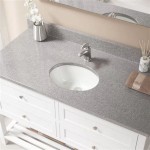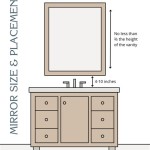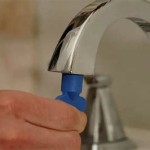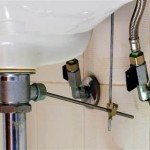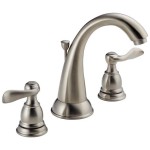Bathroom Sink Faucet Stopper: A Comprehensive Guide
The bathroom sink faucet stopper, often overlooked, plays a crucial role in the functionality of a bathroom. It allows users to retain water in the sink basin for various purposes, from washing hands and faces to shaving and cleaning. This seemingly simple component comes in a variety of designs, materials, and mechanisms, each with its own advantages and disadvantages. Understanding the different types of sink stoppers and their associated issues can help homeowners choose the right option for their needs and troubleshoot common problems effectively.
Types of Bathroom Sink Faucet Stoppers
Several types of sink stoppers are commonly found in bathrooms, each with a unique mechanism for opening and closing. These mechanisms directly impact the ease of use, maintenance requirements, and overall lifespan of the stopper.
Pop-Up Stoppers: The pop-up stopper is arguably the most common type found in modern bathrooms. It operates through a lever located either behind the faucet or on the faucet body itself. This lever connects to a horizontal rod that extends to the drain assembly. When the lever is moved, it pivots the rod, which in turn lifts or lowers the stopper, opening or closing the drain.
The advantages of the pop-up stopper include its ease of use and relatively sleek design. Also, the mechanism is partially concealed, contributing to a cleaner aesthetic. However, the pop-up mechanism can be prone to hair and debris accumulation, which can hinder its smooth operation. Regular cleaning of the stopper and the connected linkage is generally required to maintain optimal functionality. Also, alignment issues with the pivot rod and stopper can arise, requiring adjustments to the mechanism.
Lift-and-Turn Stoppers: This type of stopper features a knob or lever directly on the stopper itself. To close the drain, the user lifts the stopper slightly and then turns it. This action engages a mechanism that locks the stopper in the closed position. To open the drain, the user lifts and turns the stopper in the opposite direction to release the locking mechanism.
Lift-and-turn stoppers are known for their simplicity and durability. The direct connection between the knob and the stopper eliminates the need for external linkages, reducing the potential for mechanical failure associated with remote activation systems. However, the direct manipulation of the stopper can make it less hygienic compared to lever-operated types. Also, the twisting motion can sometimes become stiff or difficult, especially if the stopper is not regularly cleaned and lubricated.
Push-Button Stoppers: Push-button stoppers, as the name suggests, operate through a simple push-down mechanism. Pressing the stopper down engages a spring-loaded or detent mechanism that locks it in the closed position. Pressing it again releases the mechanism, allowing the stopper to pop up and open the drain. These stoppers often have a streamlined and modern appearance.
The push-button design is generally considered convenient and user-friendly. The lack of external levers contributes to a clean aesthetic. However, the internal mechanisms of push-button stoppers can be relatively complex and prone to failure. The small parts within the stopper can be difficult to access for cleaning or repair, and the spring mechanisms can weaken over time. Also, certain models can be less effective in creating a tight seal, especially if debris accumulates around the stopper.
Flip-Top Stoppers: Flip-top stoppers feature a pivoting disk attached to a central post. To close the drain, the disk is flipped down, covering the drain opening. To open the drain, the disk is flipped up, allowing water to flow freely. The design is simple and visually distinct.
Flip-top stoppers are relatively inexpensive and easy to install. Their simple design reduces the potential for mechanical failure. However, they often do not provide as tight a seal as other types of stoppers, potentially leading to slow leaks. Also, the exposed disk can collect soap scum and debris, requiring frequent cleaning to maintain hygiene and appearance. Certain styles are more prone to being accidentally dislodged.
Rubber Stoppers: These are generally a simple rubber plug that is manually inserted into the drain opening to create a seal. They are removed by hand to drain the sink.
Rubber stoppers are the most basic type, offering affordability and ease of replacement. However, they lack the convenience of other types and must be stored separately when not in use. They can also be less aesthetically pleasing and prone to wear and tear, potentially cracking or becoming misshapen over time.
Common Problems and Troubleshooting
Despite their simple function, bathroom sink faucet stoppers are often susceptible to various problems that can impede their proper operation. Understanding the common causes and troubleshooting steps can help homeowners resolve these issues without needing to call a plumber.
Clogged Stopper: One of the most frequent problems is a clogged stopper. Hair, soap scum, and other debris can accumulate around the stopper and within the drain assembly, preventing it from sealing properly or moving freely. The symptom will be a slow draining sink or a stopper that doesn't seal effectively.
To resolve a clogged stopper, begin by removing the stopper from the drain. Depending on the type of stopper, this may involve unscrewing a knob, lifting the stopper, or disconnecting a linkage. Once the stopper is removed, thoroughly clean it with a brush and a mild cleaning solution to remove any accumulated debris. Next, inspect the drain opening and the drain assembly for any obstructions. A bent wire or a specialized drain cleaning tool can be used to remove hair and other debris from the drainpipe. After cleaning, reassemble the stopper and test its operation.
Stopper Not Sealing Properly: A stopper that does not create a tight seal can lead to water slowly draining from the sink. This can be caused by a variety of factors, including debris accumulation, misalignment of the stopper, or wear and tear on the stopper's sealing surface.
First, ensure that the stopper and the drain opening are free of debris. If cleaning does not resolve the issue, inspect the stopper for any damage or wear. Rubber stoppers can become cracked or misshapen, while metal stoppers can develop corrosion or rough edges. If the stopper is damaged, it may need to be replaced. For pop-up stoppers, check the alignment of the pivot rod and the stopper itself. Adjust the pivot rod to ensure that the stopper sits properly in the drain opening. Sometimes tightening the nut on the pivot rod can secure the position.If all else fails, try using a small amount of silicone grease around the stopper, ensuring not to use too much to create future clogs.
Stiff or Difficult Stopper Movement: A stopper that is difficult to move or turn can be caused by friction between the stopper and the drain opening, corrosion or buildup on the stopper mechanism, or misalignment of the linkage.
Begin by cleaning the stopper and the drain opening to remove any debris or buildup. Applying a small amount of lubricant, such as silicone grease or plumber's grease, to the stopper and the moving parts of the mechanism can help to reduce friction. For pop-up stoppers, check the pivot rod and the connecting linkages for any signs of corrosion or bending. Clean and lubricate the linkages as needed. If the stopper is still difficult to move, it may be necessary to disassemble the stopper mechanism and thoroughly clean and lubricate all of its parts.
Choosing the Right Stopper
Selecting the right bathroom sink faucet stopper involves considering several factors, including aesthetic preferences, budget constraints, and ease of maintenance. There is no single "best" stopper for all situations, so it's essential to weigh the pros and cons of each type to make an informed decision.
Aesthetic Considerations: The stopper should complement the overall style of the bathroom. For a modern bathroom, a sleek push-button or pop-up stopper may be a good choice. For a more traditional bathroom, a lift-and-turn or flip-top stopper may be more appropriate. The finish of the stopper should also match the finish of the faucet and other bathroom fixtures. Polished chrome, brushed nickel, and oil-rubbed bronze are common finish options.
Ease of Use: Consider the ease of use of the stopper. Pop-up and push-button stoppers are generally considered to be the most convenient to operate. Lift-and-turn and flip-top stoppers require more manual effort. Rubber stoppers are the simplest but least convenient.
Maintenance Requirements: Some stoppers require more maintenance than others. Pop-up stoppers, with their complex linkage mechanisms, are prone to clogging and may require more frequent cleaning. Push-button stoppers can also be challenging to clean due to their intricate internal components. Lift-and-turn and flip-top stoppers are generally easier to maintain due to their simpler designs.
Budget: The price of bathroom sink faucet stoppers can vary widely depending on the type, material, and finish. Rubber stoppers are typically the least expensive option, while more elaborate designs like push-button stoppers can be more costly. Consider your budget when making your selection and balance cost with the features and benefits that are most important to you.
Durability and Material: The material of the stopper affects its durability and resistance to corrosion. Metal stoppers, such as those made of brass or stainless steel, are generally more durable than plastic stoppers. Rubber stoppers can degrade over time, especially if exposed to harsh chemicals or extreme temperatures. Choose a stopper made of a material that is appropriate for the bathroom environment and that will withstand regular use.
In conclusion, the bathroom sink faucet stopper is a seemingly insignificant but critical component of a functional bathroom. By understanding the different types of stoppers, their common problems, and the factors to consider when choosing a stopper, homeowners can ensure that their bathroom sink operates smoothly and efficiently for years to come.

Pop Up Lift Turn Pull Out Stopper Bathroom Sink Drains

Fixing Tricky Pop Up Drain Sink Stopper Mechanisms Efficient Plumber

Sink Drains Stoppers At Com

Bathroom Drain And Wet Vent Sink Stopper Repair

How To Replace A Sink Stopper Quick And Simple Home Repair

Drain Stopper Bathroom In Chrome Rp5648 Delta Faucet

Bathroom Sink Pop Up Stopper Parts Diagram Drain Plug
Install A Drain Stopper So The Is Removable

Faucet Bathroom Sink Drain Stopper Pop Up Without Overflow For Vessel

The Plumber S Choice 1 5 8 In Bathroom Faucet Universal One Touch Vessel Vanity Sink Pop Up Drain Stopper Without Overflow Brushed Nickel 2301r Home Depot
Related Posts

